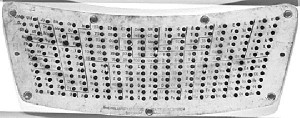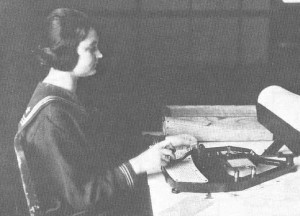In class today we talked about the results from the survey passed out during last class. It was found that people liked the concept map as well as learning about Ada and Babbage’s relationship. It was also found that people were unclear on how the analytical machine and other machines worked. Dr. Wagstaff encouraged us, if we were interested, to consider doing our final project on it, so that we may explain how it works to the class. Also, people were unclear on how much work Ada actually did on the notes and how much Babbage helped her. The fact is that we’re really not sure how much she did and probably never will. Also, the vast majority thought that the class work was about right at the moment. However, Dr. Wagstaff has decided to drop one of the assignments, so that we have two weeks to do each assignment.
In class, we had an activity where we wrote two questions that we would put on a “quiz” about the reading from last time. The first one being a “how” question and the second being a “why” questions. The questions were passed around and each person had to write down the answered and then the answers were passed around and “graded”. We then discussed things that we found interesting about the questions and answers.
- How did Hollerith’s machine get and store data?
Punched cards were used to input data. These were put in the machine which interpreted them. We thought that it was interesting that the machine had constraints on what would be considered valid data. These constraints included that cards could only be put in one way. This was done by making one of the corners of the card cut at an angle. This way the card could only be putting the reader one way. Another restraint was that the card was considered invalid if two mutually exclusive things were entered. So for example if male and female were selected the card was considered invalid. Also, if the user was only looking at one type of cards (males for instance) if another type of cards (females for example) was inputted it would be tossed out.
Cards were punched through a pantograph, which was basically a template through which holes were punched. The machine was composed of a tabulator and a sorter. Click here for some good images of the machine. The tabulator counted up everything by lowering down a tray with pins attached to it; if there were was a hole where the pin was it would go through the hole into a cup of liquid mercury. The mercury acted as a very good conductor and would make an electrical current. Part of the reason mercury was used is that the whole device was hooked up to a battery (they didn’t have a power grid during this time), so the voltage across the device was very poor. The sorter flipped open the bin to put in the card, but someone still had to manually put each card in the sorter.
2. Why was it necessary for Hollerith to make this machine
With the 1890 census it would not be able to finish the census before the next census (in 10 years). The 1880 one took 7 years to complete and there were more people in 1890 than 1880. For the 1890 census there was a race to see what method/machine could do the best, which would be used for the next census. One was Hollerith’s machine, one was a chip method which used different colored paper, and one was the slip method which used different colored ink. They had a race in which they had to process 10,000 cards. The chip method took 110.933 hours for transcription and 44.683 hours for tabulation, the slip method took 144.4167 hours for transcription and 55.367 hours for tabulation, and Hollerith’s method took 72.45 hours for transcription and 5.467 hours for tabulation. So, that makes Hollerith’s method a little over twice as fast as the chip method and a little over two and a half times as fast as the slip method.
We talked also about how single-minded Hollerith was. Hollerith only thought of one use for his machine: the census, and didn’t consider his machine’s usefulness for other scenarios, such as other data entry.
Next we went through an activity to see how long it would take for our hometown’s census to be processed back in the day. With Hollerith’s machine it took 25 seconds/person for transcription and 2 seconds/person for tabulation.
Example for my hometown: Sherwood, OR
Population 18,194
Transcription=25*18194=4.55E5 seconds=7.58E3 minutes=1.26E2 hours=5.26 days
Tabulation=2*18194=3.64E4 seconds=6.065E2 minutes=10.1 hours
Total=1.36E2 hours=5.67 days
We then talked about why the US was able to set up new things like the machine for the census, when Europe had just kept with people doing the census. One of the reasons is that the US had just gotten out of the civil war and was really far behind Europe, so the US was open to innovation. Another reason was that it would theoretically save time and money. However, for the years it saved the census, they spent it doing even further analysis on it! In the end, they ended up spending twice as much money as the 1880 census!
Images from: http://www.columbia.edu/cu/computinghistory/census-tabulator.html



The machine that Hollerith created actually was a great tool for Nazi during the Holocaust: http://www.ibmandtheholocaust.com/